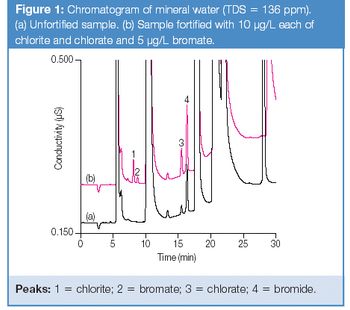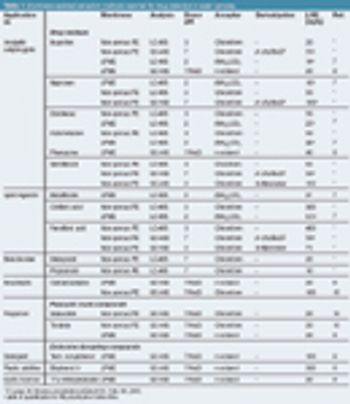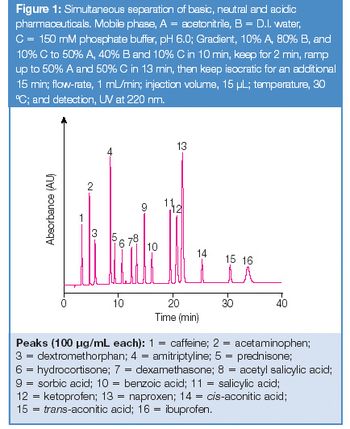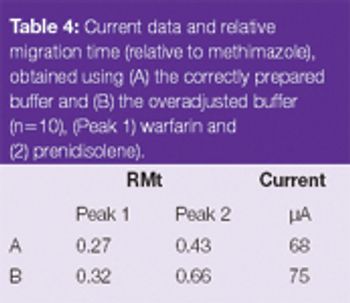
LCGC Asia Pacific
Agilent tours Asia Pacific region; Instrumental analysis exhibition; Joint research and development agreement

LCGC Asia Pacific
Agilent tours Asia Pacific region; Instrumental analysis exhibition; Joint research and development agreement

LCGC Asia Pacific
Mass overload is related to the mass of sample that can be injected before the stationary phase is sufficiently loaded to cause changes in the chromatography.

LCGC Asia Pacific
Chromatography at the Australian Centre for Research on Separation Science (ACROSS), University of Tasmania; Chromatography at the Australian Wine Research Institute; Separation Science at the University of Western Sydney; Natural product analysis at Charles Sturt University; Chromatography at the Australian Centre for Research on Separation Science (ACROSS), RMIT

LCGC Asia Pacific
LC–MS–MS methods for the unambiguous identification and quantification of pesticides in complex matrix samples are well known and widely used. Triple quadrupole systems have proven useful for this task because of their high specificity in MS–MS mode and their low detection limits. However, working in targetted MS–MS mode prevents the detection of other compounds.


LCGC Asia Pacific
Very low level detection of mycotoxins in the agriculture products has become increasingly important. Mycotoxins are very resistant fungal metabolites that can remain in foods after processing and, sometimes, even after cooking. They are considered potent carcinogens and can be found in many varieties of foods. Of the mycotoxin class, aflatoxins are considered especially harmful, being both acutely and chronically toxic. Aflatoxin B1 and B2 are some of the most potent hepatocarcinogens known. Along with aflatoxins G1 and G2, even extremely low levels of these aflatoxins in the diet are important public-health concerns. With this in mind, this application note describes a specific, robust HPLC method for the low-ppb detection of aflatoxins B1, B2, G1 and G2 in corn.

LCGC Asia Pacific
The concept of membrane-controlled processes is widespread in nature. Nearly all biological mechanisms concerning mass transport and exchange are regulated by membrane barriers and a variety of technical and biotechnological applications have been devised based on this mechanism. Membrane applications in analytical chemistry are geared towards the enrichment of target substances from an aqueous solution or the separation of compounds from a complex matrix. This article describes membrane-assisted extraction processes to separate traces of polar pharmaceutical substances the so called emerging micropollutants from aqueous samples. Basic prospects and examples of membrane-supported extractions are presented.


LCGC Asia Pacific
Mixed mode chromatography combines aspects of ion exchange chromatography and conventional reversed-phase (RP) chromatography. The combination of both hydrophobic and ion-exchange properties allows for independent control of retention for ionizable and neutral molecules.

LCGC Asia Pacific

LCGC Asia Pacific
UltraPerformance LC (UPLC) has been widely accepted by chromatographers because of improvements over HPLC in the sensitivity, resolution and speed of separations. As scientists begin to use this technology for impurity and metabolite profiling, they will need to transfer the methods to preparative LC to isolate and purify their compounds for further research. Therefore, it is necessary to systematically transfer UPLC assays not only to HPLC, but, more importantly, to preparative chromatography. In this application, we provide information on how to scale a UPLC impurity/degradant separation to a preparative LC separation.

LCGC Asia Pacific
Suppressed conductivity detection is a well-developed method for detecting charged species. Reversed-phase high-performance liquid chromatography (RP-HPLC) is a well developed method of separating substances on the basis of hydrophobicity. There are some situations where it is advantageous to use these two methods together. Perfluoro-acids (PFOAs) are one class of compounds that are ionic, hydrophobic and have low UV absorbance and are, therefore, suited to this combination.

LCGC Asia Pacific
Accurate preparation and correct selection of buffers is essential to obtain reproducible and consistent results in capillary electrophoresis (CE). A number of factors should be considered in buffer optimization, including the pKa of the buffering ion and the analyte as well as the molarity of the acid or base used in the adjusting procedure. Accurate recording of the precise reagents used and the procedures performed is necessary to prepare buffers consistently.

LCGC Asia Pacific
Polycyclic aromatic hydrocarbons (PAHs) are commonly found throughout the environment in soil, water and adsorbed to fine particulate matter in air. Of the 16 common PAHs, 7 have been classified as animal carcinogens by the International Agency for Research on Cancer (IARC). Resulting from this classification, PAHs are monitored and regulated in the environment.